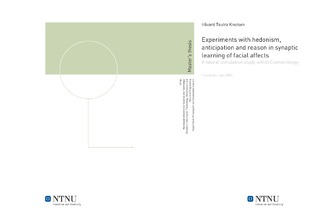Experiments with hedonism, anticipation and reason in synaptic learning of facial affects: A neural simulation study within Connectology
Master thesis
Permanent lenke
http://hdl.handle.net/11250/251193Utgivelsesdato
2007Metadata
Vis full innførselSamlinger
Sammendrag
Connectology consist of three basic principles with each their own synaptic learning mechanism: Hedonism (the Skinner synapse), Anticipation (the Pavlov synapse) and Reason (the Hume synapse). This project studies the potentials and weaknesses of these mechanism in visual facial affect recognition. By exploiting the principles of hedonism, a supervision mechanism was created with the purpose of guiding the Pavlov synapses' learning towards the goal of facial affect recognition. Experiments showed that the network performed very poorly, and could not recognize facial affects. A deeper study of the supervision mechanism found a severe problem with its operation. An alternative supervision scheme was created, outside the principles of Connectology, to facilitate testing of the Pavlov synapses in a supervised setting. The Pavlov synapses performed very well. The synapses correctly anticipated all affects, however one of the four affects could not be discriminated from the others. The problem with discriminating the fourth affect was not a problem with the Pavlov learning mechanism, but rather of the neuronal representation of the affects. Hume synapses were then introduced in the hidden cluster. This was done to facilitate the forming of neuronal concepts of the different facial affects in different areas of the cluster. These representations, if successfully formed, should allow the Pavlov synapses to both antipate and discriminate between all facial affects. The forming of concepts did not happen, and thus the Hume synapse did not contribute to better results, but rather degraded them. The conclusion is that the Pavlov synapse lends itself well to learning by supervision, futher work is needed to create a functioning supervision mechanism within the principles of Connectology, and the application of the Hume synapse also calls for futher studies.
